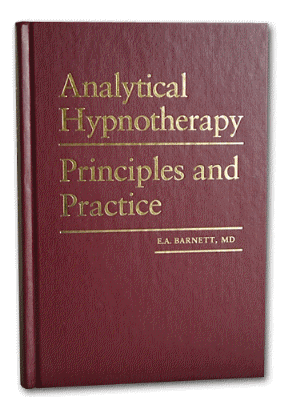
Analytical Hypnotherapy: Principles & Practice
In this book, Dr. Edgar Barnett has given us a clear and incisive evaluation of various methods of incorporating hypnosis into the healing arts.
Each practitioner can take what is needed to improve results without having to change personal philosophy or greatly altering a personalized pattern of therapy already developed.
Dr. Barnett has had long experience as a family doctor in England and, since 1966, in Canada. A doctor must know where to look and how to ask before setting about to help a troubled person escape into healthy adaptive freedom in our stressful world. Dr. Barnett is eminently qualified for these responsibilities.
He knows that successful therapy depends heavily on two major elements – a willingness for change on the part of the patient and a constant belief that a constructive goal will be reached.
However, the verbalized request for help and the consciously expressed willingness for change can be misleading. They are the tip of the iceberg; beneath are contradictory forces of assumed guilt, habits of illness, habits of failure,unfavourable dramatized indentifications and unrecognized destructive drives. Newer techniques of hypnoanalysis make it possible to recognize these sources of resistance early in the therapeutic process. Dr. Barnett offers these methods to the reader and shows how resistance can sometimes be circumvented or even eliminated without damaging the self respect of the patient.
Hypnosis and analytical hypnotherapy have an important difference. Direct suggestion in hypnosis is a one-way communication from therapist to patient. The immediate response of the patient is not a necessary part of the therapy (although it is rare for any therapist of note to limit himself to direct suggestion without availing himself of such responses as might occur to monitor the progress of his patient.) On the other hand, sensitive and detailed two-way communication is an essential part of analytical hypnotherapy.
Much of this book is devoted to detailing those responses which are of particular value in maintaining this two-way communication. In the sections in which case histories are reported in detail, the obvious responses are described. Every hypnotherapist is aware, however, that many of the responses of his patient are detected at an unconscious level, a sensitivity which the therapist can acquire only through experience. Nevertheless, every attempt has been made to clarify all the principles of analytical hypnotherapy as they occur in practice.
TESTIMONIAL BY DAVID B CHEEK, M.D.
SAN FRANCISCO, CALIFORNIA
Doctor Barnett is blessed with an infectious and communicable faith in the potential for good in people. It has been my privilege to witness this gift in action, to find it demonstrated in his teachings and in his writings. His faith and his method of projecting that faith are deserving of careful study by those reading this book. Without that projected faith any attempt to help troubled people may fail. It is not enough to learn ways of uncovering negative subconscious attitudes; we must also be strong in our convictions. We know it will happen; we expect it to happen.
In this book, Dr. Edgar Barnett has given us a clear and incisive evaluation of various methods of incorporating hypnosis into the healing arts.
Each practitioner can take what is needed to improve results without having to change personal philosophy or greatly altering a personalized pattern of therapy already developed.
Though this book is now out of print please contact the author as some copies are still available.
It is being used as course text by the Hypnotherapy Academy of America
